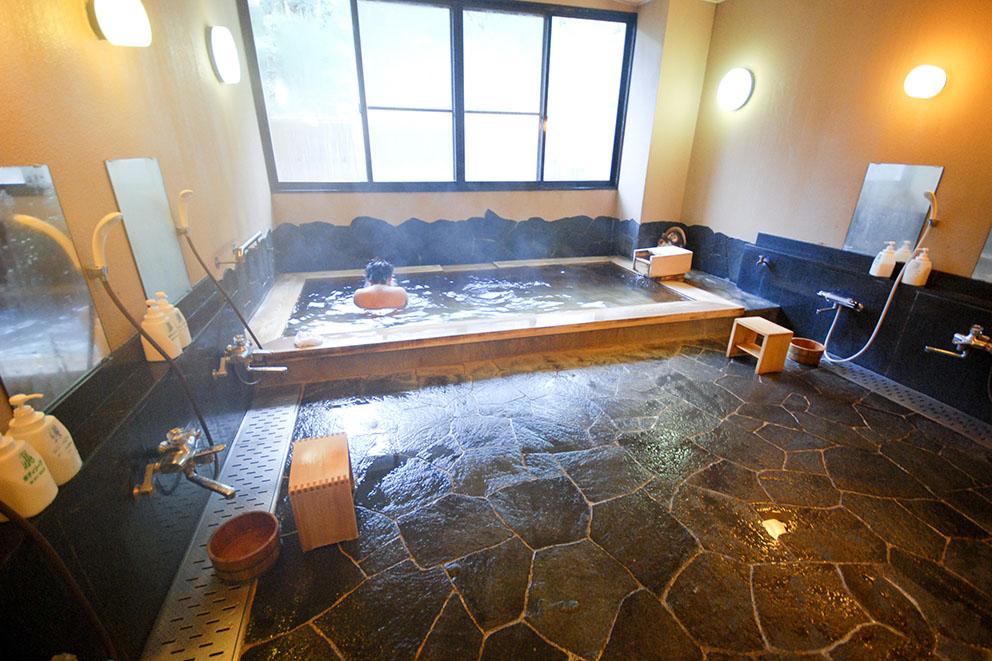
The Japanese Bath
Enjoying a Japanese bath is a unique cultural experience. For first-timers it may be a little intimidating, but once you get used to it, the Japanese bath often becomes an addiction; relaxing, healing, and regenerating its followers.
Below is a general outline of the layout of a sample bath (either hot spring or not), a simple how to bathe guide, and some tips. Learning a few pointers will help you navigate the watery world of the Japanese bath smoothly.
Entrance
The entrance to baths are often marked by “noren” curtains; blue for male and red for female. Most baths require you to take of your shoes or slippers before entering. Sometimes accommodations switch baths, the bath that is for men in the evening may be for women the next morning, so confirm the correct one before entering.
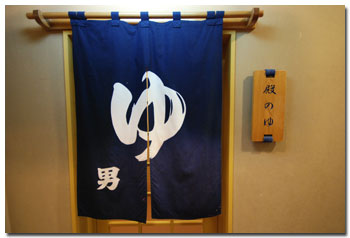
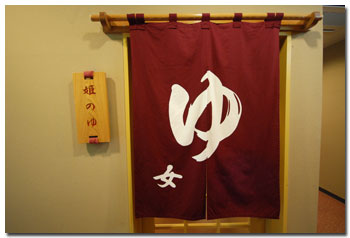
Change room
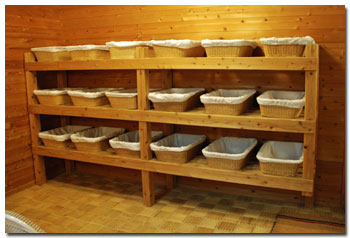
The change room often contains lockers or baskets for your clothes. Others provide chairs, hairdryers, and other amenities.
Bath
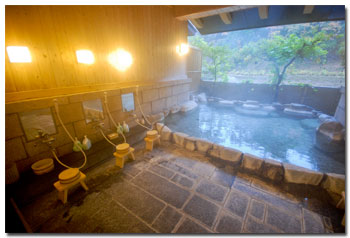
There is a multitude of styles of baths including indoor and outdoor. The washing area and bathing areas are separate. Clean yourself in the washing area and soak in the bathing area.
How to Bathe
The very essence of the bathing routine is as below for both hot springs and public baths.
- Take off clothes in change room
- Rinse or wash body
- Soak in bath
- Relax and enjoy!
Be observant. Watch the people around you so that you know what is going on. Most places follow these general guidelines, but some do differ slightly. The main thing is to remember to keep the bathwater separate from the washing water and be polite and courteous to other bathers.
Tips
Below are a list of tips that might offer some hints on ways to make your Japanese bath experience the best possible. These tips also cover basic bathing etiquette.
Before
- Confirm which is the male and female baths. Often the color of noren hanging curtain is red for female and blue for male. Sometimes accommodations switch baths, so the bath that is for men in the evening may be for women the next morning.
- The male entrance is often marked with this character “男” and the female with this character “女”.
- Go to the toilet before entering the bath as many onsens do not have toilets inside the changing room.
- Drink some water, etc. beforehand to prevent dehydration.
- Watch where you need to take off your shoes or slippers. Footwear is most often not allowed in the change room.
- Put your valuables in locker if available. Some keys can attach to the wrist.
- Take off your clothes in the change room and put them in a basket or locker.
- Remove jewellery, accessories, and watches, as these can be discolored by the minerals in the water.
- Glasses can also be damaged by the minerals in the water, especially the coating on the lenses. It is best not to dip your them in the bath.
- Tie your hair up if it is long.
- You can cover yourself with the small modesty towel while walking between the change room and bath for privacy.
- Do not drink too much alcohol or eat to much before entering the bath.
During
- Towel use: while walking around the bath naked many men tend to hold their little towel in front of the genitals, while women use both hands to hold the towel to cover breasts and genitals. As the bath is entered, the towel magically moves to the top of the head, only to return to the previous position as the user emerges from the bath.
- Walk slowly, the floor of the bath can be slippery.
- Wash or rinse your body outside of the bath. Sometimes people do a quick rinse, then soak for a little while, and then do a thorough washing, returning to the bath again after they are clean.
- If you do a quick rinse, crouch beside the bath and you can scoop out water from the bath with a washbowl to rinse your body. Start with the feet and shins, then onto the legs and your body. A few washbowls full of water is OK. Remember this is done outside of the bath, next to it. The water that you rinse yourself with should not go back into the bath.
- If the bath does not have a shower, use the washing buckets, fill them up with tap water or scoop water from the bath itself.
- Sit on the stools when you are washing. If you are standing water can easily splash onto the people nearby or into the bath.
- Hold onto the shower nozzle when turning on the water. If the water pressure is high, the shower hose could get out of control, writhing around like a snake, shooting water all over the place. Quite comical but frowned upon by other bathers.
- Most facilities supply soap and shampoo, but some public baths do not, so you may need to bring your own.
- Tidy up your washing space after you finish. Rinse your stool and washbowl. You can then return your washbowl and stool to where you got them or simply turn your washbowl upside down and set in on top of the stool.
- Turn the faucet back to warm if you take a cold shower. Or you may surprise the next person who uses it!
- Enter the water slowly to allow your body to adjust to the temperature — which can be hot — around 40~44 degrees Celsius.
- Greet others in the bath in a friendly manner when you get in.
- Avoid yelling or talking in a loud voice.
- Do not bring books or newspapers in the bathing area.
- Do not put your head under the water in the bath.
- Do not put soap or shampoo in the bath.
- Do not put your towel in the bath.
- Set you towel on your head or the side of the bath.
- If your towel accidentally falls into the bath, wring it out outside the bath.
- When soaking, feel free to get in and out of the bath many times. Sitting on the side with only your feet in is OK.
- Watch your body temperature and try not to get too hot. If you start feeling ill, get out of the bath.
- Stand up slowly in the bath. If stand up too quickly, you could faint. Fainting in the bath is dangerous and there are many injuries reported throughout Japan every year because of this, especially for first-timers who soak for too long.
- Dry off as much as you can before returning to the change room with your modesty towel. Keep the change room as dry as possible.
- Some hot springs don’t recommend that you rinse off after the bath to obtain the full effect of the minerals in the water. But if you have sensitive skin it is best to rinse.
- No swimming suits are allowed. There are a few outside baths that do allow guests to wear swimsuits. Please double check with the accommodation whether or not it is OK to do so before you use the bath.
- Don’t swim in the bath.
- In most baths taking photographs and videos are not allowed.
- Don’t wash clothes in the washing area or bath.
- No smoking in bathing area.
After
- Remember to retrieve your stuff that you put in the locker.
- Drink something after you bath, it is important to rehydrate.
- Sometimes there are relaxing rooms for bathers to sit or lay down in after bathing. Often there are massage chairs as well!
- Do not place your wet towel on tatami flooring mats.
Other Notices
- It is often recommended to bathe no more than three times a day.
- Do not bring babies into the bath if there is a possibility of them urinating.
- Menstruating women should refrain from using communal baths.
Regarding Tattoos
Tattoos are often associated with the Japanese mafia, and some inns in Japan prefer to not serve this clientele, but this does not usually apply to international guests staying at accommodations so much in the Kumano area.
If you have a tattoo of something that might be seen as offensive or violent, as a courtesy to other guests in Japan not used to such things, you might consider using tape or a bandage to cover it. Please note that in some places, it might not be acceptable to put taped or bandaged body parts into the onsen.
However, this has not been an issue in the rural area, please enjoy the trip and the hot spring bath.
Family Physician Advice
As a family physician, my advice to any visitors is: avoid alcohol and dehydration before going to the hot spa, as often the blood pressure drops (not increase as many people believe) in response to hot water immersion. If the blood pressure drops too much then fainting (loss of consciousness) can occur.
Sweating from the head while immersed in hot water is an indication that the body is overheated and is trying to cool itself down. Get out of the hot water, cool down with a coolish shower before thinking about re-entering the bath.
Many medications, not just blood pressure medication but also angina, Parkinson’s disease and antidepressant medications (not a complete list, there are lots more) can also lower blood pressure excessively when combined with high body temperatures.
